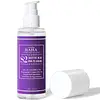What's inside
What's inside
 Key Ingredients
Key Ingredients

 Benefits
Benefits

 Concerns
Concerns

 Ingredients Side-by-side
Ingredients Side-by-side

Water
Skin ConditioningGlycerin
HumectantButylene Glycol
HumectantDimethicone
EmollientCetyl Ethylhexanoate
EmollientNiacinamide
SmoothingPentylene Glycol
Skin ConditioningHamamelis Virginiana Extract
Antiseborrhoeic1,2-Hexanediol
Skin ConditioningPolysorbate 60
EmulsifyingAmmonium Acryloyldimethyltaurate/Vp Copolymer
Acrylates/Beheneth-25 Methacrylate/Hema Crosspolymer
Emulsion StabilisingTromethamine
BufferingCyclopentasiloxane
EmollientPhenoxyethanol
PreservativeGlyceryl Stearate
EmollientSalicylic Acid
MaskingSorbitan Sesquioleate
EmulsifyingPEG-100 Stearate
Cyclohexasiloxane
EmollientAcrylates/C10-30 Alkyl Acrylate Crosspolymer
Emulsion StabilisingCaprylyl Glycol
EmollientPolyacrylamide
Chondrus Crispus Extract
Skin ConditioningC13-14 Isoparaffin
EmollientParfum
MaskingSaccharum Officinarum Extract
MoisturisingTorreya Nucifera Seed Oil
EmollientGlyceryl Acrylate/Acrylic Acid Copolymer
HumectantZea Mays Starch
AbsorbentMicrocrystalline Cellulose
AbsorbentMannitol
HumectantLaureth-7
EmulsifyingDisodium EDTA
Melaleuca Alternifolia Leaf Oil
AntioxidantCI 77288
Cosmetic ColorantSucrose
HumectantCentella Asiatica Extract
CleansingEthylhexylglycerin
Skin ConditioningTocopheryl Acetate
AntioxidantSalix Nigra Bark Extract
Skin ProtectingCitric Acid
BufferingAscorbic Acid
AntioxidantCamellia Sinensis Leaf Extract
AntimicrobialAloe Barbadensis Leaf Water
MaskingWater, Glycerin, Butylene Glycol, Dimethicone, Cetyl Ethylhexanoate, Niacinamide, Pentylene Glycol, Hamamelis Virginiana Extract, 1,2-Hexanediol, Polysorbate 60, Ammonium Acryloyldimethyltaurate/Vp Copolymer, Acrylates/Beheneth-25 Methacrylate/Hema Crosspolymer, Tromethamine, Cyclopentasiloxane, Phenoxyethanol, Glyceryl Stearate, Salicylic Acid, Sorbitan Sesquioleate, PEG-100 Stearate, Cyclohexasiloxane, Acrylates/C10-30 Alkyl Acrylate Crosspolymer, Caprylyl Glycol, Polyacrylamide, Chondrus Crispus Extract, C13-14 Isoparaffin, Parfum, Saccharum Officinarum Extract, Torreya Nucifera Seed Oil, Glyceryl Acrylate/Acrylic Acid Copolymer, Zea Mays Starch, Microcrystalline Cellulose, Mannitol, Laureth-7, Disodium EDTA, Melaleuca Alternifolia Leaf Oil, CI 77288, Sucrose, Centella Asiatica Extract, Ethylhexylglycerin, Tocopheryl Acetate, Salix Nigra Bark Extract, Citric Acid, Ascorbic Acid, Camellia Sinensis Leaf Extract, Aloe Barbadensis Leaf Water
 Reviews
Reviews

Ingredients Explained
These ingredients are found in both products.
Ingredients higher up in an ingredient list are typically present in a larger amount.
1,2-Hexanediol is a synthetic liquid and another multi-functional powerhouse.
It is a:
- Humectant, drawing moisture into the skin
- Emollient, helping to soften skin
- Solvent, dispersing and stabilizing formulas
- Preservative booster, enhancing the antimicrobial activity of other preservatives
Camellia Sinensis Leaf Extract is derived from the leaves of the tea plant. Black tea, green tea, and oolong tea are all harvested from this plant.
This ingredient has many skin benefits:
This ingredient contains polyphenols, a strong antioxidant. Antioxidants help fight off molecules that damage skin cells.
On top of that, the antioxidants in green tea neutralize free-radicals from the sun. This gives the skin some extra UV protection, but should not replace sunscreen.
Many components of tea have anti-inflammatory properties.
Polyphenols and L-theanine help soothe the skin and reduce irritation. The caffeine in Camellia Sinensis Leaf Extract helps calm inflamed blood vessels.
Other compounds found in tea include: Vitamin Bs, linoleic acid, magnesium, calcium, iron, and zinc.
Research has shown both drinking Camellia Sinensis Leaf Tea and applying it to the skin can help boost skin elasticity and hydration. Studies also show using tea extract may reduce sebum, or oil, production.
Learn more about Camellia Sinensis Leaf ExtractNiacinamide is a multitasking form of vitamin B3 that strengthens the skin barrier, reduces pores and dark spots, regulates oil, and improves signs of aging.
And the best part? It's gentle and well-tolerated by most skin types, including sensitive and reactive skin.
You might have heard of "niacin flush", or the reddening of skin that causes itchiness. Niacinamide has not been found to cause this.
In very rare cases, some individuals may not be able to tolerate niacinamide at all or experience an allergic reaction to it.
If you are experiencing flaking, irritation, and dryness with this ingredient, be sure to double check all your products as this ingredient can be found in all categories of skincare.
When incorporating niacinamide into your routine, look out for concentration amounts. Typically, 5% niacinamide provides benefits such as fading dark spots. However, if you have sensitive skin, it is better to begin with a smaller concentration.
When you apply niacinamide to your skin, your body converts it into nicotinamide adenine dinucleotide (NAD). NAD is an essential coenzyme that is already found in your cells as "fuel" and powers countless biological processes.
In your skin, NAD helps repair cell damage, produce new healthy cells, support collagen production, strengthen the skin barrier, and fight environmental stressors (like UV and pollution).
Our natural NAD levels start to decline with age, leading to slower skin repair, visible aging, and a weaker skin barrier. By providing your skin niacinamide, you're recharging your skin's NAD levels. This leads to stronger, healthier, and younger looking skin.
Another name for vitamin B3 is nicotinamide. This vitamin is water-soluble and our bodies don't store it. We obtain Vitamin B3 from either food or skincare. Meat, fish, wheat, yeast, and leafy greens contain vitamin B3.
The type of niacinamide used in skincare is synthetically created.
Learn more about NiacinamideSalicylic Acid (also known as beta hydroxy acid or BHA) is a well-known ingredient for treating skin that struggles with acne and clogged pores. It exfoliates both the skin's surface and deep within the pores to help clear out buildup, control oil, and reduce inflammation.
Unlike AHAs (alpha hydroxy acids), salicylic acid is oil-soluble. This allows it to penetrate into pores which makes it especially effective for treating blackheads and preventing future breakouts.
Salicylic acid is also known for its soothing properties. It has a similar structure to aspirin and can calm inflamed or irritated skin, making it a good option for acne-prone skin that is also sensitive.
Concentrations of 0.5-2% are recognized by the U.S. FDA as an over-the-counter topical acne product.
It can cause irritation and/or dryness if one's skin already has a compromised moisture barrier, so it's best to focus on repairing that before introducing this ingredient into your routine.
While salicylic acid does not increase sun sensitivity, it’s still important to wear sunscreen daily to protect your skin.
If you are looking for the ingredient called BHA or Butylated Hydroxyanisole, click here.
Learn more about Salicylic Acid